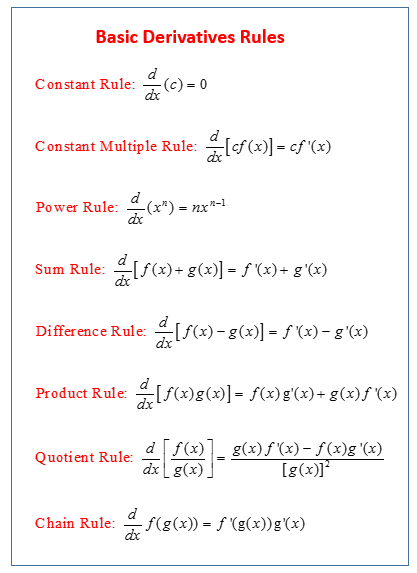The slope of a constant value (like 3) is always 0 the. Let n be a positive integer if f (x)= x.

Calculus - Power Rule, Sum Rule, Difference Rule (Video Lessons, Examples, Solutions)
I.e., d/dx (f (x) ± g (x)) = d/dx (f (x)) ± d/dx (g (x)).

Derivative sum rule. The derivative tells us the slope of a function at any point. The sum rule of differentiation can be derived in differential calculus from first principle. This mathguide math education video derives (proof) the sum rule for derivatives using the definition of a derivative.derivative:
The sum rule says that the derivative of a sum is equal to the sum of each individual. There are rules we can follow to find many derivatives. The derivative of a function which is the sum of two or more parts is equal to the sum of the derivatives of each part.
Use the quotient rule for finding the derivative. If a function y ( x) is the sum of two functions u ( x) and v ( x), then we can apply the sum rule to determine the derivative of y ( x). Sid's function difference ( t) = 2 e t − t 2 − 2 t involves a difference of functions of t.
In leibniz's notation this is written as: The sum and difference rules. F ( x) and g ( x) are two differential functions and the sum of them is written as f ( x) + g ( x).
11) quotient rule example 3; Hello,i am jiya.i am a teacher. The sum rule is used to find the derivative of a function that contains a sum of other functions.
01) review/derivative of composite function; Use the product rule for finding the derivative of a product of functions. Apply the sum and difference rules to combine derivatives.
Let y ( x) = u ( x) + v ( x). 21 rows find the fourth derivative of f ( x) = 2 x5 f (4) ( x) = [2 x5 ]'''' = [10 x4 ]''' = [40 x3 ]'' = [120 x2 ]' = 240 x derivative on graph of function the derivative of a function is the slop of the. This channel covers all the basic concepts of maths.all lecture videos are available for classes 1 to 8th and class 9th 10th.
This rule applies to subtraction as well. Derivative sum difference — formula constant multiple rule the constant multiple rule states that if c is a constant and f (x) is a differentiable function, then: The derivative of a sum is equal to the sum of the derivatives.
Differentiation is linear [ edit] for any functions and and any real numbers and , the derivative of the function with respect to is: 10) quotient rule example 2; The power rule tells us that if a function is an algebraic expression raised to a power, then the derivative has a power of 1 less than the original function.
Sum/difference rule of derivatives this rule says, the differentiation process can be distributed to the functions in case of sum/difference. There are differentiation laws that allow us to calculate the. A property of limits is the.
We now have all the pieces to prove the derivative rule involving f ( x) + g ( x ). To take the derivative of a sum, you break apart the sum into single expressions,. This website uses cookies to ensure you get the best experience.

Differentiation Rules - Proof Of Sum Rule - Youtube

Finding Derivatives Of Sums, Products, Differences & Quotients | Study.com